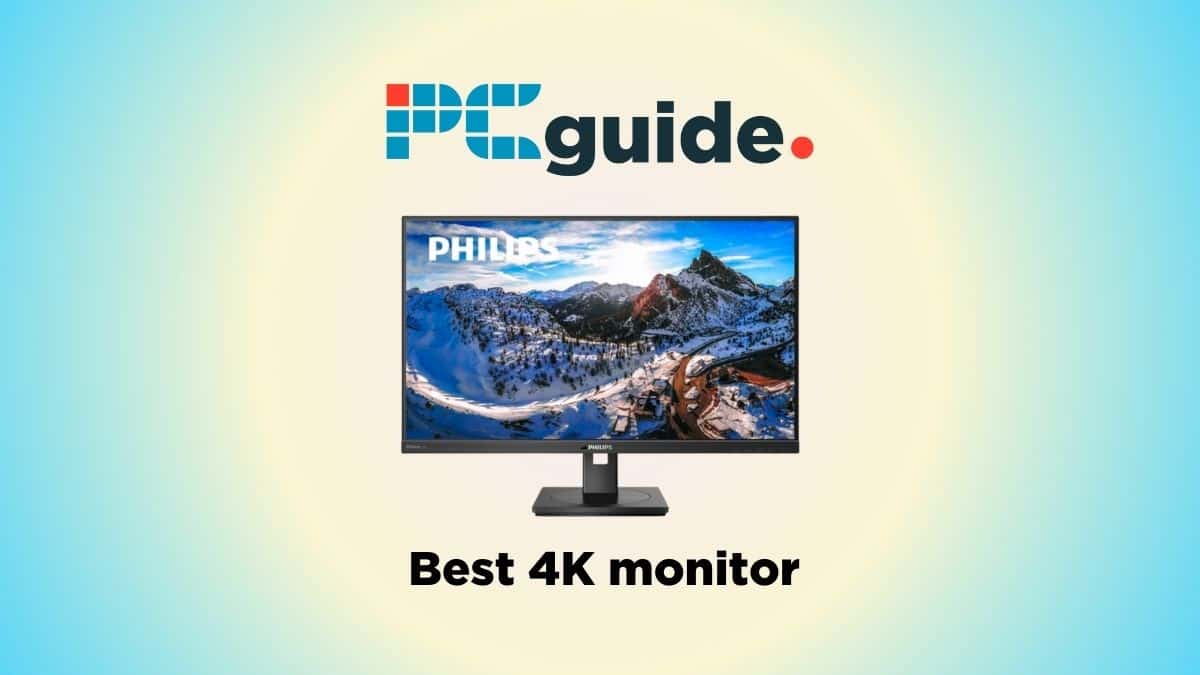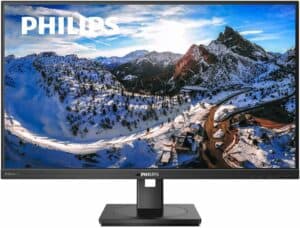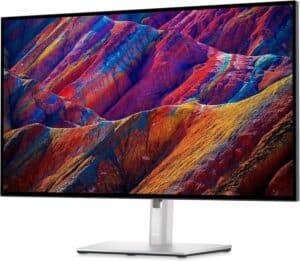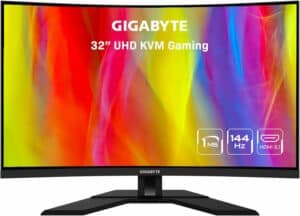Best 4K Monitor 2023 – for photography, business, curved

Table of Contents
The market for high-resolution monitors has been rapidly expanding over the past few years, so we’ve curated this buying guide to the best 4k monitor in 2023. The context of selecting a 4K monitor extends far beyond just resolution, and that’s where we come in. In this article, we’ll explore the leading 4K monitors that stand out in today’s market, offering exceptional clarity, color accuracy, and performance.
4K– also known as 4K Ultra HD– is defined in consumer electronics as a resolution of 3840 x 2160, or 2160p. This is a marked improvement over 1440p and 1080p and is equivalent to four 1080p images stitched together. Even if you can’t run your games at a full 4K resolution, a 4K display will also provide a much cleaner-looking desktop interface and easier-to-read text, which is a bonus for those who spend a lot of time working on their PC. If you’re finally considering the upgrade to a 4K resolution monitor, we’ve found you some great starting points.
Products at a Glance
How we picked the best 4K monitor
Picking the best 4K monitor isn’t a task we take lightly, and our selection process involves a comprehensive review of both user reviews and publically available benchmarks, as well as drawing on our in-depth topic knowledge of PC monitors. We assess each monitor’s resolution and panel technology to ensure sharp, clear 4K images with accurate color representation. Given that this is not a gaming-specific list, we’ve made sure to weigh in on which monitors are more suitable for photography and graphic design too, which rely on color accuracy, brightness, contrast ratios, and viewing angles.
In addition to display quality, we consider the overall performance of the monitors, including response times and refresh rates, which are particularly important for the gaming side of things. We also look at the range of connectivity options and assess the build quality and ergonomic design of each monitor.
While the focus of this article is on finding the best 4K monitor, you can find a wealth of buying guides across the sight that provide options for different monitors to help you in sourcing an upgrade. For example, we’ve also explored the best monitor for home office, and of course, the best gaming monitors too.
Product Reviews
- UltraClear 4K resolution and color accuracy
- USB-C docking with power delivery
- Ergonomic adjustments with SmartErgoBase
- Limited refresh rate for gaming
- May be pricey for budget users
- 27-inch size may be small for some users
The Philips Brilliance 279P1 is a 27-inch LCD monitor offering UltraClear 4K UHD resolution (3840×2160) and an IPS panel for wide-viewing angles and full colors. It’s equipped with a 10-bit panel, enhancing color accuracy, making it suitable for tasks requiring precise color representation. The monitor’s USB-C docking station, which provides power delivery up to 65 watts, adds to its versatility, allowing for simultaneous laptop charging, video, and USB-C signal transmission.
This monitor is ideal for professionals and enthusiasts seeking a combination of high resolution and color accuracy in a moderately sized display. The built-in stereo speakers add convenience for multimedia applications, and its SmartErgoBase enables ergonomic adjustments for height, tilt, rotation, and pivot, enhancing user comfort. Its 60 Hz refresh rate is standard for professional use, focusing more on clarity than speed.
- High color accuracy and wide gamut coverage
- Ergonomic design with adjustability
- USB-C connectivity with power delivery
- Premium price point for professional features
- 60 Hz refresh rate not suited for high-end gaming
- Large size requires ample desk space
The BenQ SW321C PhotoVue is a 32-inch 4K IPS monitor specifically tailored for photographers and video editors. It offers exceptional color accuracy, factory calibrated, and includes a calibration report. With AQCOLOR Technology, it ensures accurate reproduction of colors, making it reliable for color-critical work. Covering 100% sRGB, 95% P3, and 99% AdobeRGB, it’s ideal for a wide range of professional creative tasks. The monitor also features hardware calibration with a 14-bit 3D LUT for precise color blending.
This monitor is perfect for professionals who require consistent color accuracy between their screen and print outputs. BenQ’s Paper Color Sync technology allows for screen-to-print consistency, a crucial feature for photographers and designers. The ergonomic design, including tilt, pivot, swivel, and height adjustment, adds to user comfort. Moreover, the USB-C connectivity with 65W power delivery and a USB hub makes it a versatile workstation addition.
- Crisp 4K UHD resolution
- Multiple adjustment features for comfort
- Versatile connectivity options
- 60 Hz refresh rate is not ideal for high-end gaming
- 27-inch size may be small for some users
- Premium price for business features
The Dell UltraSharp 27 4K USB-C Hub Monitor (U2723QE) is a versatile 27-inch monitor that combines 4K UHD resolution with a comprehensive range of adjustments, including tilt, swivel, pivot, and height. It offers a 16:9 widescreen resolution, making it perfect for movies, video games, and office work. The anti-glare, 3H hard coating, and pixel pitch of 0.1554 mm enhance the viewing experience. Its 60 Hz refresh rate and 5 ms GTG response time make it suitable for action films, sports, and gaming.
This monitor is ideal for business users and gamers who appreciate sharp visuals and the ability to tweak monitor settings for optimal ergonomics. Connectivity options like HDMI and VESA mount compatibility add to its versatility, catering to different user setups.
- High 144Hz refresh rate
- 4K resolution with a wide color gamut
- Curved design for an immersive experience
- High-end gaming specs increase price
- Large size requires ample desk space
- Curved design may not suit all preference
The Gigabyte M32UC is a high-performance 31.5-inch curved gaming monitor offering a stunning 4K UHD display. It features a 144Hz refresh rate (160Hz OC) and a 1ms (MPRT) response time, providing an immersive and smooth gaming experience. The monitor covers 93% DCI-P3 and 123% sRGB color gamuts and is VESA DisplayHDR 400 certified. Its curved design enhances the viewing experience, particularly for gaming and multimedia applications.
This monitor is a top choice for gamers seeking high refresh rates and responsive performance at 4K resolution. The wide color gamut ensures vibrant and accurate colors, essential for both gaming and creative work. Features like KVM support, OSD Sidekick, and multiple connectivity options including HDMI 2.1 and DisplayPort 1.4, enhance its functionality, making it a versatile option for various user needs.
Buying the best 4K PC monitor
If you aren’t familiar with all the specifications and technical terms we’ve been tossing around, that’s okay. With this section of the article, we have you covered, and we’ll make sure you have a better understanding of what you’re dealing with. In case you still have any lingering questions after reading this buying guide, feel free to comment below and ask for assistance– we’d be happy to help you.
For now, though, let’s answer the most pressing questions.
Screen Size and PPI
Screen size matters for more than just the physical space the screen occupies on your desk. Take two monitors with the same resolution, then shrink one down by a few inches. If you were to then look at these monitors side-by-side, you would realize that the smaller one looks even clearer, since the pixel density is much higher.
With this in mind, giving simple screen size and resolution measurements doesn’t tell the whole story about how clear a monitor will actually look in front of you. Taking into account common viewing distance, a monitor will look fairly unclear if it doesn’t meet at about ~90 PPI. 24-inch 1080p monitors meet this target just fine, but still, aren’t exactly high-fidelity.
With 4K monitors like the ones in this article, you’ll see that our PPI measurements far exceed that target. In common desktop usage, this will result in much sharper, clearer text, and a far-improved multitasking experience. In gaming, provided you have the graphics horsepower to back it, you’ll see a massive improvement in overall clarity and fidelity.
Recommended Hardware
If you’re a gamer and want hardware capable of making the most of one of the monitors listed above, take a look at this section.
Upscaled 4K Hardware
- A PS4 Pro or Xbox One X (or higher). The former generally upscales from 1440p, and the latter generally upscales from 1800p. In rare scenarios, games will be played at native 4K on these devices. Still, if you get one of the HDR enabled monitors, then you’ll have an extremely crisp viewing experience.
- An RX 580 or GTX 1660 (or higher). These cards are capable of native 4K at console-equivalent settings in many titles, or 1440p/1800p upscaling at higher settings.
- A GTX 1660 Ti or RTX 2060 (or higher). Same as above, but with a higher trend toward 1800p.
Native 4K Hardware
- Nvidia: RTX 2070 and higher
- AMD: Radeon VII and higher
Refresh Rate and Display Overclocking
In this section, we’re going to discuss refresh rate. Quite a few monitors on this list have a refresh rate above 60 Hz, and if you aren’t familiar with display technology, you may not know what that means.
To put it simply, refresh rate counts the number of times a monitor refreshes in a second. This is measured in Hertz. It corresponds to the FPS (frames per second, or framerate) that the monitor can display. With a high refresh rate monitor, you’ll actually be able to see framerates above 60 FPS, which translates to a competitive advantage in many games.
- 60 Hz/60 FPS – The standard for a smooth experience. Most displays use this, but not all console games meet this performance target.
- 120 Hz/120 FPS – Super-smooth. Offers the greatest noticeable improvement over 60 Hz/FPS.
- 144 Hz/144 FPS – Hyper-smooth. A bit of a marginal improvement over 120, but still the industry standard. If every frame matters to you, a 144 Hz monitor is key.
G-Sync, FreeSync, and VRR
VRR stands for “Variable Refresh Rate”, and refers to technologies that adjust a monitor’s refresh rate on-the-fly to adjust to changes in framerate.
In scenarios where a monitor’s refresh rate doesn’t match with in-game framerate, screen-tearing is common. In the past, gamers used V-Sync to combat this problem, but it came at the cost of lower performance and higher input latency. With VRR technology, however, this same effect can be achieved at no performance or latency cost to the end user.
G-Sync and FreeSync are essentially identical VRR technologies, built into a monitor and supported by a graphics card. The only meaningful difference is that one corresponds to Nvidia and the other corresponds to AMD. Current-gen Nvidia GPUs can now use FreeSync, too, which means Nvidia users don’t need to worry about which monitor they choose. (This doesn’t go the other way around, unfortunately; AMD users cannot utilize G-Sync monitors.)
While we didn’t encounter this issue, some users are encountering flickering issues when using FreeSync. This is actually somewhat common in monitors, especially when using an HDMI cable instead of DisplayPort. We recommend using a DisplayPort cable with these monitors for ideal FreeSync performance. If you’re gaming on an Xbox One X, make sure you have an HDMI 2.0-rated cable, or turn off FreeSync to prevent flickering.
Response Time
Response time measures the amount of time a pixel takes to “respond”, which usually means going from gray-to-gray. This is related to input lag, but doesn’t always tell the whole story.
In general, though, lower is better.
- 1-2 ms – The best, but only achievable by TN panels.
- 3-5 ms – Pretty solid, and the best an IPS panel can manage.
- 6+ ms – Not recommended in smaller displays (ie monitors). Will likely feel laggy.
Panel Type
Panel type refers to the type of panel the monitor is built with. We’ve listed the two relevant panel types that appear in this article below.
- TN – Faster response times, lower input latency. Comes at the cost of worse color reproduction and viewing angles. Recommended for competitive gamers.
- IPS – Far better color reproduction and viewing angles. Comes at a slight cost to input latency and response time. Recommended for most gamers.
Should I use HDR on my 4K monitor?
Yes, using HDR on your 4K monitor can enhance the visual experience by providing higher contrast, more vivid colors, and greater detail in both bright and dark areas of the picture. However, it’s important to have content that is HDR-compatible to fully benefit from this feature. HDR can significantly improve the viewing experience for movies, games, and other multimedia content that supports it.
Is a 4K UHD monitor good?
Absolutely, a 4K UHD monitor is a great choice for those seeking high-resolution displays. With four times the resolution of standard 1080p monitors, 4K monitors offer sharper and more detailed images, making them ideal for a variety of uses, including professional graphic design, video editing, gaming, and general multimedia consumption.
Our Verdict
Final thoughts
Weighing in on the verdict of the best 4K monitor, the Philips Brilliance 279P1 distinguishes itself with its ultra-clear 4K UHD resolution, wide-viewing angles, and color accuracy, making it an excellent choice for a variety of users, from professionals to everyday enthusiasts. Its ergonomic design, USB-C docking capabilities, and built-in stereo speakers further enhance its appeal, offering a combination of high performance and convenience.
The BenQ SW321C PhotoVue is ideal for photographers and videographers. The Dell UltraSharp 27 4K USB-C Hub Monitor strikes a balance between professional use and gaming, while the Gigabyte M32UC is the go-to choice for gamers seeking a high refresh rate and immersive curved display.



